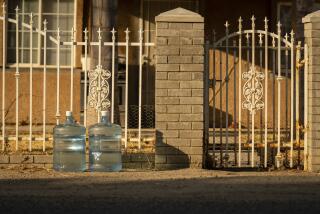Quenching Our Growing Thirst
- Share via
California’s constant search for new sources of water reminds me of the famous line from the classic poem “Rime of the Ancient Mariner,” by Samuel Taylor Coleridge: “Water, water everywhere, nor any drop to drink.”
It is the frustrated cry of a desperate sailor who senses the irony that he is dying of thirst at sea, surrounded by undrinkable water. A similar lament has also been repeated for generations by Southern Californians as we beg, borrow and deal for the clean drinking water that we so desperately need, despite our proximity to the ocean.
Our water supply is dwindling, and our growing population is only increasing the problem. The federal government has given California a deadline to reduce by 800,000 acre-feet annually its share of Colorado River water--which means the water supply for about 1.6 million California families will soon evaporate.
Farmers and environmentalists have teamed up in an attempt to reduce the amount of water Southern California imports from Northern California. To make matters worse, the Orange County Water District announced that the Orange County aquifer, which stores our groundwater, has been overdrafted by 133 billion gallons.
All of this is compounded by the fact that we are in the midst of a drought with no end in sight. This “Perfect Storm” of water trouble led to a recent Los Angeles Times story warning of a potential increase in water bills as our water supply shrinks.
Although we probably won’t be using green paint to brighten our dead lawns any time soon, some responsible, long-term planning is in order. Orange County needs to develop new local water sources so that we are not so reliant on imported water.
Instead of cursing the darkness, let’s try lighting a few candles.
Four days before The Times story about the overdraft in our local groundwater basin, the newspaper reported that the California Department of Health Services had granted preliminary approval for a proposed desalination facility in Huntington Beach.
This nonpolluting facility would process enough seawater to produce 50 million gallons of fresh drinking water every day. That’s more than 18 billion gallons of clean water annually, or enough to serve about 112,000 Orange County households. Desalination uses the same purifying process that bottled-water companies use.
Just as the prices of electronics have plummeted in recent years, desalination has become more affordable with advances in technology. The cost for desalinated water is now comparable to the costs of other new sources of high-quality drinking water.
However, as supplies decrease and demand rises, there is no question that water bills will increase. To put it in perspective, most families spend more for cable TV than for water and wastewater services.
We need to appreciate the value of clean drinking water, which is a limited resource.
We also have the opportunity to implement the Groundwater Replenishment System, which has been jointly proposed by the county water and sanitation districts. This recycled water will cost less than the imported water upon which we now are so reliant.
If we can use reclaimed water to irrigate crops, water golf courses and parks, and recharge our overdrawn aquifer, then our other clean water sources -- including desalination, groundwater and imported water -- will ensure Orange County a sufficient supply of drinking water.
In addition to developing new water sources and effectively managing our existing ones, conservation is an important component to avoiding a water crisis. Southern California residents have been practicing conservation since our last major drought in 1992, but more can be done.
Water industry experts and Metropolitan Water District officials estimate water consumption could be reduced by 10% by not overwatering lawns, washing only full loads in our washing machines and dishwashers and adopting other common-sense water conservation habits.
Even with new water sources and incorporating water conservation measures, we will still need imported water. However, by developing new local water resources such as desalination, we become more independent and less reliant on water from Northern California and the Colorado River.
Just as it is important to diversify one’s financial portfolio, it is equally important to have a diverse water portfolio.
We need to implement all these alternatives in order to guarantee that Orange County will continue to have affordable access to local, reliable, high-quality drinking water. If we move forward implementing all our alternatives, we can turn Coleridge’s poem around and proudly exclaim, “Water, water everywhere, and now it’s ours to drink!”
More to Read
Sign up for Essential California
The most important California stories and recommendations in your inbox every morning.
You may occasionally receive promotional content from the Los Angeles Times.










